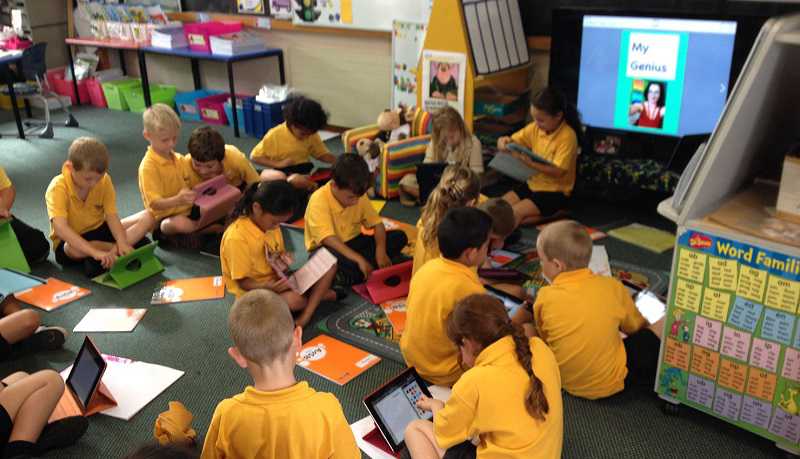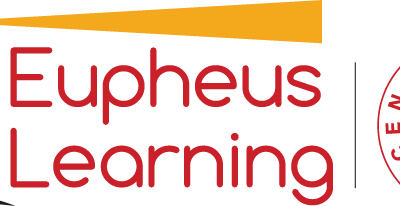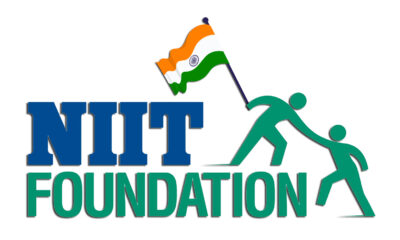Knowledge
How technology is changing the face of education?
Technology has resulted in 3 new styles of learning in classrooms— personalization, differentiation and individualization. The cost of introducing these in the classrooms is progressively decreasing along with increasing learning outcomes.
Published
8 years agoon

All spheres of life touched by mobile, internet or personal technology has literally metamorphosed and given incredible outcomes. Take the example of ticketing, online shopping and many other examples. The list is almost endless where technology has enabled mass personalization.
No other country has embraced mobile, the internet and the concept of connected technology like the USA, needless to say technology is now knocking on the doors of education. This has resulted in the advent of new learning styles or what are popularly called “neomillennial“ styles. Such styles have now gained enough momentum to be formally categorized under 3 categories — personalization, differentiation and individualization.
The U.S. Department of Education’s 2010 Education Technology Plan defines the 3 types as — personalization is when the lessons are tailored to learning preferences an individual learner, differentiation means tailoring the content to the learning preferences of groups of learners and finally individualization is when instruction is paced to the learning needs of different learners.
While differentiation and individualization has always existed in school systems to meet students’ learning needs and goals, technology offers a much wider scope for personalization, whereby, each individual’s intent, interest and learning profile are targeted through identification of content, process and product. Such personalisation in education allows students to completely own their learning process as they can choose their learning objectives as well as the pace of learning.
Prima facie, it might seem that designing and integrating personalisation in K-12 education may be expensive, it surprisingly isn’t so. In 2010, a survey instituted by the Greaves Group showed that an investment of $298 per student per year on migrating from a regular classroom to a 1-to-1classroom results in a potential savings of more than $400 per student per year.
Ideally, in personalized learning, students should be able to work from outside the school at the hours of their convenience, either individually, through a collaborative effort and be free to communicate with peers and teachers. This assumes availability of expanded internet/device access. Here the schools will have to step in and use their purchasing power to negotiate lower-cost licenses and contracts for digital content and online courses that students can access from their homes. Alternately, the simpler way out could be that the schools can extend the school hours.
Perhaps the biggest advantage of individualization of education through technology is for the at-risk children. Augmented Reality can make it possible to design interactive programs that allow students to see and explore concepts from different angles. Indeed, a research of at-risk high school students in Texas showed that interactive environments helped in better assimilation of content than traditional means like lecture, note taking, drill and practice. However, the research also pointed out the importance of blending instruction with technology that allow students to solve problems on their own or collaboratively with other students.
The success of the marriage of technology and education depends on effective leadership at all levels of society. Teachers, administrators, parents, students and educational policy makers must work together on a range of tools to optimize school operations and decide budgetary allocations for introducing technology in schools. Most importantly, all stakeholders must recognize that personalization of education is making the whole learning experience more efficient and effective with teachers and not without them.
Inspiration
Remembering Kargil Vijay Diwas: A Lesson in History, Sacrifice, and Peace for Our Children
Published
19 hours agoon
July 26, 2024
Today is the Kargil Vijay Diwas, a day of victory for the Indian armed forces celebrating 25 years of victory in the Kargil War of 1999. This day represents pride and strength of the nation, as well as a reminder of the price that is paid in any armed conflict. While appreciating the courage and the efforts of our soldiers on this day, it is equally important to explain its importance to our children.
Understanding the wars of the past is essential for the younger generation. The Kargil War was a high-altitude conflict between India and Pakistan, fought in the treacherous terrain of the Kargil district in Jammu and Kashmir. Despite the harsh conditions and the strategic disadvantage, the Indian Army emerged victorious, reclaiming the occupied territories. This victory, achieved through immense bravery and sacrifice, is a testament to the indomitable spirit of our armed forces.
It is always good to celebrate victories in war as a sign of prowess, but it is equally important to pass this message to the young: War should always be the last solution. These depictions of bravery during the Kargil War should evoke feelings of respect and gratitude for those who sacrifice their lives to secure our freedom and security. However, it should also highlight the importance of peace and non-violence. India’s history is rich with examples of resolving conflicts through diplomacy and non-violence, a legacy of ahimsa championed by leaders like Mahatma Gandhi.
Schools play a pivotal role in shaping the perspectives of young minds. By incorporating lessons on the Kargil War and other significant historical conflicts, educators can instil a deeper appreciation for the freedom and security that we often take for granted. These lessons should not only be of triumphs in battle; they should also include the destruction and suffering that war entails. This way, students will be able to appreciate the efforts of the soldiers and have a deeper respect for the armed forces and their principles.
However, it is also important to complement these stories with the ones of peace and diplomatic victories. Explaining India’s policy of non-violence and the use of diplomacy in the conflict can help children learn about the benefits of living in harmony with others and the effectiveness of negotiations over fighting. This dual approach makes sure that while we are rejoicing and acknowledging our champions, we are also promoting peace and proper utilization of authority.
Therefore, Kargil Vijay Diwas is not only a day of victory and celebration but also a day when our children should be made aware of the bitter truth of war and the need for peace. In this way, we can raise a generation that appreciates freedom, honors the soldiers’ sacrifices, and aims at a society where people solve their problems with understanding and not violence.
Education
Nurturing Natural Skills: Empowering Youth for the Future
Published
2 weeks agoon
July 16, 2024
On World Youth Skills Day celebrated on 15 July globally, it’s essential to recognize the incredible potential children inherently possess. Children are naturally curious, energetic, and less afraid of taking risks—qualities that, if nurtured correctly, can form the bedrock of their future success. By identifying and developing these skills, we can empower them to become resilient and adaptable adults ready to face the challenges of the future.
Curiosity: The Catalyst for Learning
Curiosity drives children to explore, ask questions, and seek out new experiences. This innate desire to understand the world around them is a powerful tool for learning. Encouraging curiosity through inquiry-based learning and fostering an environment where questions are welcomed can significantly enhance their educational experience. For instance, project-based learning allows children to dive deep into subjects that interest them, promoting critical thinking and problem-solving skills.
Energy: Channeling Enthusiasm into Productivity
Children are bursting with energy, which, when directed correctly, can lead to incredible productivity and creativity. Schools and parents can harness this energy by providing varied activities that challenge both mind and body. Extracurricular activities like sports, music, and arts not only keep them engaged but also teach them discipline, teamwork, and perseverance. Moreover, incorporating movement into learning, such as through kinesthetic activities, can help maintain their focus and enhance memory retention.
Fearlessness: Embracing Risks and Learning from Failure
Children’s fearlessness and willingness to take risks are qualities that can drive innovation. Creating a safe environment where they can experiment, fail, and learn from their mistakes is crucial. By teaching resilience and the value of perseverance, we can help them develop a growth mindset. Activities that encourage trial and error, such as coding, robotics, and creative writing, can instill confidence and the ability to view failures as opportunities for growth.
Developing These Skills into Strengths
To turn these innate skills into lasting strengths, it is essential to provide continuous support and opportunities for development. Teachers and parents play a pivotal role in this process by:
- Providing Diverse Learning Experiences: Exposure to various subjects and activities helps children discover their interests and strengths. This broadens their horizons and fosters a love for lifelong learning.
- Encouraging Collaborative Learning: Group projects and team activities teach children the importance of collaboration, communication, and empathy. These skills are invaluable in both personal and professional settings.
- Promoting Self-Reflection: Encouraging children to reflect on their experiences helps them understand their strengths and areas for improvement. This practice can build self-awareness and intrinsic motivation.
- Integrating Technology: Leveraging technology in education can make learning more engaging and accessible. Interactive tools and resources can cater to different learning styles and keep children excited about their educational journey.
By recognizing and nurturing the natural skills of curiosity, energy, and fearlessness in children, we can transform these qualities into powerful strengths. This approach not only prepares them for future challenges but also equips them with the resilience and adaptability needed in a rapidly changing world. On World Youth Skills Day, let’s commit to fostering these attributes, ensuring that the youth of today become the innovative leaders of tomorrow.
Edutainment
A Story About Turning Math Anxiety into Achievement
Published
1 month agoon
June 24, 2024
“Grow up dear and start solving your own problems”.
This popular meme floating on social media always triggers my thinking. It seems to be an age-old way to vent out the stress created by the subject. The last few decades have seen so much shift in the teaching-learning pedagogy, however, the math phobia remains. Researchers have proved that around 50 percent of the population is affected by math anxiety. It is more prevalent in women than in men. Also, it can start as early as age 5 when numbers are being just introduced. Philosophers and thinkers list various reasons for the same. Going through all those reasons I realized that teaching-learning practices are at their core. We need to update them and sync them with needs of the Gen X.
Thus began my journey of unlearning and relearning my math skill. I had to do it for my students, to ensure no stress classroom during math lessons. I started reading, exploring experimenting to have students love the subject. As Math skill will go with them beyond schooling years, for which they need a strong base.
Enters Shriya, whose smile seems to vanish as soon as she heard me say “Let us start with Math now”. Shriya, generally a regular and independent student, who actively took part in various class engagements frequently missed online math lessons. When approached, she very happily would blame it on the net or state some random excuse.
But then started her ordeal of physically being present in my class after the schools reopened post-pandemic. Her parents had already confided in me about her math phobia. Shriya too very innocently stated that “It’s so boring, I cannot even mute the call, close the screen, and have to listen to you”.
“OK Dear!” was my reply. “Let us make the class a little interesting for you. Would you like to give out numbers to classmates to solve?” With a heavy heart, she came forward and picked out the number card and flashed it for her peers to note and start their calculations. While I was busy interacting with other students Shriya sat silently looking at the numbers she had picked. Students around her were busy playing with numbers and trying to solve the given task. Once the class completed the task, we all thanked Shriya for taking those numbers out for us. As the task had turned out to be easy because of that. We collectively decided to make her the star of the day.
I started involving Shriya more and more during the math lesson, giving her responsibilities and involving her in various simple random tasks. To my surprise, Shriya would wait for taking out numbers for the upcoming math lessons. However, as a class rule, we could not give her a chance again, so she decided to sit and be on the other side. I quietly whispered into her years that she could pick her own numbers to do the task. And am glad I did that as she picked up easy numbers to solve the given task. Though she missed out on getting the golden star, which I give out for all correct, I asked her to draw out an ice cream cone for herself for a good attempt. “Do colour the cone with your favourite ice cream flavour” And she smiled.
During the morning circle time, I started with simple math based games, like boom bam, make a sentence, and math magic tricks with students. They really liked it and tried to guess the solution. They started asking friends from other sections and became math magicians. Shriya however still did not have the courage to approach peers as she was not confident with her calculations. So she took the trick home and tried it with her family. She practiced it a couple of times before she confronted them. I was her first audience. Even with her first few fails, I could read her eyes, how much she wanted to taste success here. As a result of emotional learning curriculum being done in school, peers too came forward and supported her. The encouragement she got from there boosted her morale so much that she could not stop talking about it in class.
Then came the concept of fractions where all-time favorite pizza is frequently used as an example. I used stories as a tool to introduce the concept. Students were involved in a follow up activity, which gave them hands-on learning experience of the concept. Once the basics was understood, I moved on to using pizza as an example and every time Shriya would solve fractions properly, I would message her mother, who in turn would cater for a pizza meal.
“My family sat around the table and I had to give one fifth of the pizza to all members”, reported Shriya, the very next day. Great dear, today try eating two thirds of apple pieces at home. I was confident that Shriya would be able to calculate how many pieces of apple to eat, as I had already messaged her mother to cut the apple into six pieces. Shriya was able to make 3 groups of the given apple pieces, but not able to decide how much to eat, so she send me a pic over WhatsApp. I just replied with a guiding question and next minute got a smiling picture with correct apple pieces next to a smiling face.
Shriya then volunteered to take a flip classroom for the next math lesson on fractions. She not only prepared herself for the explanation but also got worksheets ready for her peers. Shriya even gave out stars to all students who deserved them as per her, and in turn, she got the gold star from me. I had to encourage her for her efforts.
Next few concepts, saw Shriya taking a keen interest in the subject and trying her level best. Stumbling at places, this new Shriya did not mind redoing the task. She now had understood that understanding basics were the key to success and that one day she would get the gold star for all correct tasks.
I on my end kept on with my research and tried to make my lesson more engaging, interactive and one with which students could connect with. A mock market was set up in class to practice the concept of money. A number line was made on the floor for understanding decimals. Hopscotch was used for jumping on place values in the international number system. Students played the game of battleship after understanding the coordinates. The class game of Housie was customized to revisit and recap the concepts done. “Who will become the next millionaire” TV show was enacted in my class with a student sitting on the hot seat till they give correct answers to mathematical questions.
Finally came the day, Shriya not only earned her golden star, but it did not stop there, as she was now aiming to get the Math Marshall badge I gave out to students who not only mastered the concept but were ready for peer teaching. And the day she did that, I realized that Math had itself solved its own problem by being supportive in Shriya’s journey from a math hater to a math lover.
Authored By-
Smriti Sajjanhar,
PBL Coordinator,
Bugle Editorial Board, Genesis Global School, Noida

Yes, you read it correct. Am I referring to a real or metaphorical potato? Give it a guess now. What it could be? Of course, the real potato could be used as a visual aid to talk about shape and size in early years classroom or it could be used to understand the concept of heavy objects sinking in water. Art specialists would use it as a stencil and mathematicians may use it to explore weight and measurement. Physics students might use the same potato for lighting a bulb, while chemistry and biology students might want to explore its atomic nature and reactions.
Great guessing, as all the above guesses are correct. In addition to the above we also have another potato there, waiting to adjust to our needs and requirements. Let me give you another clue by tickling your critical thinking skill.
Potato : Cooking :: ________ : Teaching
Bulls eye! Now you have got it. Just like potato, which can be used anywhere and in any form of cooking, stories too can be used anywhere and in any form within the teaching and learning process. They gel very well with all resources , concept and caters for varied requirements of a classroom setting.
Potato : Cooking :: Stories : Teaching
Stories are at the core of all our memories, we seem to have inbred liking for them, and students are no different from us. Stories teach us everything about life and when used within the four walls of classroom they can create magic. Let us understand why, how, and what is behind this magic.
Why is Storytelling the most effective Teaching Tool?
- Oldest form of education– Even before the invention of language man has been telling stories to teach his leanings in form of cave paintings. Later he used signs and symbols to express his feelings.
- Emotional connect – stories go straight to heart. Information and facts will be forgotten, but incidences are remembered in form of stories.
- Motivates and encourages– It is Scientifically proven. According to Paul Zak, a neuroscientist, when we listen to stories, chemicals like dopamine and oxytocin are released which help in increased motivation and attention.
- Makes us open minded – Stories have been used to pass down beliefs, traditions, and history to future generations, thus appreciate cultures. They are very resourceful in creating awareness and being responsible global citizens.
- Stimulates the imagination – Stories transport us to a different world altogether, thus tickling and stimulating our imagination, which might lead to innovation.
- Boosts memory – They are easy to remember. Psychologist Peg Neuhauser states that learning which results from a well-told story is remembered more precisely and for longer duration in contrast to learning from facts and figures. Jerome Bruner’s, another psychologist supports the above study through his research which suggest that facts are 20 times more likely to be remembered if they’re part of a story.
- Develops skills – listening is the first and most basic skill developed through stories. Listening is not only an essential survival skill but also it is imperative for developing other soft skills as well, namely comprehension, critical thinking to begin with. Stories are also helpful in painting the larger umbrella of communication skill with special reference to writing and retelling stories.
- Foresee the unseen – enable children to empathise with unfamiliar people/places/situations. offer insights into universal life experiences
When and Where can is Stories be used as teaching Tool?
- As a brain breaker – To break the monotony and promotes a feeling of well-being and relaxation
- To share personal experiences. – Increase children’s willingness to communicate thoughts and feelings
- To introduce a new topic – Leaving a story unfinished will help students think. This can serve as a provocation to build the lesson on. From English to math, art to science, each and every topic could be covered through story.
- To illustrate a concept – painting a pen picture for students helps in presentation skill as well.
- As outcome of a lesson- students can be motivated to create own stories using the newly learnt concept. Once involved their learning outcomes is not only better understood but also raises more questions in the young minds.
- To help children consider new ideas and explore new concepts. Encourage use of imagination and creativity
- Increase verbal proficiency – follow up activity after the stories ensures using the newly learnt words becomes a part of their vocabulary.
- Stories are very good assessment tools as well. They help us set the stage for assessment and then students analyze, think and come up with appropriate solutions and endings.
Who can benefit from the tool of stories?
- All classes from PreK to K12 all look forward to stories.
- To cater to VAK needs of students as there is something for everyone in a story.
- Stories can be read, seen or heard catering to individual needs.
- Stories can be used as differential tasks as well catering to needs of higher order thinking students as well.
- Stories help build up connect between the teller and listeners. They also help in enhancing social skills within the class.
What concepts and Which Stories can be used as teaching Tool?
Now that’s where the potato nature of stories come in. Stories are multitalented and multi-faceted and can suit all purposes, meet every need. It is on the teacher within you to design the best story to meet your objectives. However below are few tips which might come handy.
As per the audience – any story which your audience would connect to will work for you. Story, its language and the props used should be age appropriate. One of the earliest examples of story as a teaching tool which comes to my mind is the one which taught me, that while subtracting, I need to keep the bigger number on top.
If you have 6 candies, can you give me 10.
Yes or no, whatever the answer would be, it will certainly lead to learning. Learning not only about numbers, but also soft skill of critical thinking, reflecting and communicating. One tool, one story can change the way we teach and learn.
- As per the lesson objectives – List out the learning objectives you are aiming at during the lesson. Identify the key words from the goals. Use them for building up the story / adapting an old story.
- Follow up activity – story should be able to accommodate a follow up activity for students to reflect.
- Story Structure – selected story could have a set structure as per the story mountain or could be tweaked to meet your requirements. For example : I had once tweaked the story of “ How the Kangaroo got its pouch” to introduce the continent of Australia to first graders.
All the above points reinforce my belief in stories, their power and magic. To conclude for an educator STORY spells out as Strategic Tools to Optimize Reflections Yummily.
A is not always Apple
B is not always Ball
A could be Anecdote for some ,
While B may be basic stories for all.
A bit of Creativity and a bit of Drama
The E for Educator in you can create new experiences
by taking stories to your class.
Authored By- Smriti Sajjanhar, PBL Coordinator, Bugle Editorial Board, Genesis Global School, Noida
Inspiration
The Liberal Gift: The Key Lessons from “College – Pathways of Possibilities” by Saikat Majumdar
Published
1 month agoon
June 20, 2024
Children up to grade VI who secured a rank within the top 15 were exempted from sitting for the annual exam at the school I attended. My academic performance was below average, so I never missed writing the annual exam. During classes, I struggled to learn the notes by rote; instead, I found myself drawn to discussions and debates on the topics at hand. Unfortunately, the classroom environment rarely encouraged such interactions, with teachers predominantly delivering monologues rather than fostering open dialogue. I neither listened to the teacher’s dictation of the book nor dictated the book in my answer scripts. As a result, my academic performance suffered, and I became accustomed to being identified solely by my exam marks.
Reflecting on this, I realized I was a curious mind asking questions, but since I was not meritorious, I often felt overlooked and misunderstood by both peers and parents. However, these challenges ultimately sparked a curiosity within me that transcended boundaries of traditional education. I discovered my passion for human interaction, leading me to pursue social work and later psychology. I specialize in the intersection of psychology and social work. Along the way, I realized that economics partly determines people’s behaviour in social contexts, which expanded my interest to include economics and a bit of history to understand the origins of human societies. This varied perspective was a burden to me until I read “College – Pathways of Possibilities” by Saikat Majumdar. The author’s discourse on education liberated my mind and soul, changing the course of my life. Through reading, I have come to realize that from the very start of my educational journey, I have been fervently seeking knowledge. However, when the expectation was to solely acquire information and reproduce it for marks, I struggled.
The book acknowledges my distinctiveness and is likely to do so for any reader. It is only fair if children who are natural learners are seen as individual persons functioning collectively for knowledge, with knowledge made available collectively. The author poses a radical question to the colonial system of education that is worshiped: Can fundamental arts and science education, or fundamental education per se, be imagined accommodating every individual? This is a magical question to me! I met some students today with whom I closely work on a Psychology student magazine. I asked them, in twelve long years of their school education and one year into undergrad, were they seeking knowledge or information. Their time paused for seconds, their pupils dilated, they looked at each other and collectively said, “Information!” Isn’t this true for most of us? When school and college students are confined within this rigid system that is not eclectically inherited and approached but rather coaches them to consume volumes of information, the nation buries thinkers, engineers mediocrity, instils low self-worth, and compromises their mental health. For a populous nation like ours, the scene is tragic!
This tragic outcome can be contained by opening our minds to the philosophy of liberal education, a luminescence elucidated by the author. The framework of liberal education, as described in the book, is a distribution model where inter-related related and contra-related disciplines speak to one another, offering new perspectives. Essentially, it is a framework that is less framework. This model of education provides the foundational work that allows for choosing a well-thought-out specialization. Specialization here is not about mastering a discipline but achieving a disciplinary depth that enables critical thinking and problem-solving. After all, problems in real life do not come to us specialization-centric. Do they? Even if they seem so, the solutions are seldom specialization-centric.
To cite an example I recently came across, a renowned architect mentioned in an interview the gap between architectural academia and practice. He said that architectural engineers fail to consider the impact of climate change in their designs, thus missing out on addressing architectural dangers. The gap the architect mentions is indeed alarming, and this gap can begin to close right in the classroom by cultivating a contra-disciplinary understanding.
Liberal education can assert the emergence of true well-being, ending the rat race of firsts and seconds in educational institutions. I take this determinative stance for many reasons, coming from the perspective shift the book has driven me to acknowledge.
Knowledge! Do we acquire it, experience it, or create it? I believe knowledge is a culmination of all these. The author says there are two sides to knowledge: one is the consumption of knowledge, and the other is the production of new knowledge. We are trapped in a colonial system of education that attempts to train us to consume information, and the quantity of consumption is scored, possibly creating an uninspiring relationship with the subjects, as it did for me. Information in education is crucial, but information alone is not education; it is merely a component. Knowledge, which is education, is crucial for a life of sustenance and progress. Sadly, the colonial-influenced Indian education system is producing aspirants of information, facts, and data alone.
In a conversation with the author, he highlighted how even aspirants cracking the Indian competitive exams such as CAT, JEE, etc., focus on facts and figures but fall short on knowledge that connects them to the real world. They reach only a certain point in their careers and life overall, then lose themselves. These aspirants are supposedly the intelligent bunch, so what is the lacuna? This applies to anyone who is an active part of this education system. This broadens the vision to something primal. While information learned within a syllabus is vital, it alone does not suffice to thrive. After a certain stage, there is no syllabus handed over. It is knowledge seeking that drives the human race towards individual and collective development and well-being. How is knowledge seeking cultivated and nurtured from a young age?
The focus here shifts from the consumption of information to the consumption of knowledge. But how is this achieved? The author emphasizes the power of big-think questions in classrooms. When students studying any discipline are guided to ask and are asked big-think questions, they engage in the fundamental spirit and methodology of the discipline, as mentioned in the chapter “The Souls of Disciplines.” To quote an example from the book, history, at its heart, is a narrative of people, groups, communities, and places in time, beyond mere information about specific historical periods. Unfortunately, this spirit is often silenced under the maze of facts and information that constitute the body of the discipline, the author contends.
When education drives a student to understand the epistemic form of the discipline, she will navigate her life well with her knowledge alone, with stealth and sensitivity, without needing to rely on a syllabus for support. Life with education begins with understanding the epistemic form of one’s primary discipline of interest and extends to drawing attraction to other disciplines, either interdisciplinary or contra-disciplinary. Reading about contra-disciplinarity can leave anyone amused! Can one imagine literature and computer science communicating? The friendship between the abstraction of literature and the concreteness of computer science is disruptive, and the author calls for it for a deeper sense of knowledge. Consumed in this way, knowledge transitions into the production of new knowledge at all stages of consumption. This makes education increasingly interesting, sustaining, evolving, and useful.
What resonated with me most was the author’s perspective on teaching questions and research questions. According to the author, no question is directionless. A question that lacks a definitive answer but stimulates the mind, ignites curiosity, and encourages deeper exploration into a paradigm is a teaching question. Such questions foster openness to various perspectives, acceptance of experiences, assimilation, and the consumption of knowledge. On the other hand, the counterpart of consumption is the production of new knowledge rooted in research questions studied empirically, theoretically, conceptually, and empathetically. Research allows for a deep relationship with knowledge and the process of scientific inquiry to produce new knowledge grants one a real agency. This process of questioning, learning, and constructing knowledge cultivates critical thinking grounded in knowledge. In essence, both the consumption and production of knowledge occur through questioning. When knowledge naturally flows between consumption and production, who better than students and teachers can move in and out and back and forth? This affirms the truth that education involves lifelong consumption and production of knowledge.
The book also reflects the reality, empathizes with the plight, and identifies the aspirations of a teacher-researcher trapped in a college constrained by the Indian university system of college operations. As a professor caught between the desire to lead oneself and counterparts with knowledge and piles of files, reading the book broke the silence. Bringing change to this system requires individuals, institutions, and policies to unlearn and relearn, marking the onset of a liberal mindset for liberal education. However, it only takes openness to begin this change in my classroom.
To conclude and commence, I borrow the author’s words, “Whatever the how, here’s the now.”
Authored By-
Swathi Priya D,
Assistant Professor (Psychology),
Kumaraguru College of Liberal Arts and Science
Knowledge
Navigating Future Horizons: The Imperative Need of Updated Career Counsellors in Indian Schools
Published
1 month agoon
June 12, 2024
In the evolving landscape of education, the role of career counsellors in schools has become increasingly indispensable. Today, as we stand on the cusp of technological advancements and globalization, the need for informed career guidance has never been more critical. This article delves into the necessity of updated career counsellors in Indian schools, shedding light on misconceptions, highlighting new-age career paths, and emphasizing the importance of equipping students with the requisite skills and knowledge for their future endeavors.
Misconceptions and Realities
One prevalent misconception is that career counselling is only necessary for high school students approaching graduation. However, career development is a lifelong process, beginning as early as childhood and continuing throughout one’s professional journey. By integrating career counselling into the curriculum from an early age, students can explore various interests, talents, and aspirations, thus making informed decisions about their academic and career paths. Another misconception revolves around the notion that career counselling is solely for students struggling academically or uncertain about their future. On the contrary, career counselling is beneficial for all students, regardless of their academic prowess. It helps students align their interests, skills, and goals with suitable career pathways, fostering a sense of purpose and direction.
New Age vs. Conventional Careers
The contemporary job market is witnessing a paradigm shift, with emerging sectors such as artificial intelligence, data analytics, and renewable energy gaining prominence. While conventional careers like medicine, engineering, and law continue to hold sway, the landscape is diversifying rapidly, offering a plethora of unconventional yet promising career avenues.
In this era of innovation and disruption, students must be exposed to a spectrum of career options beyond the conventional ones. From digital marketing and sustainability consultancy to content creation and app development, the possibilities are endless. However, navigating these uncharted territories requires expert guidance and up-to-date information, underscoring the need for informed career counsellors in schools.
The Crucial Role of Career Counsellors
Career counsellors serve as the bridge between students and their future aspirations. They possess the expertise to assess students’ aptitudes, interests, and personality traits, thereby recommending suitable career pathways. Moreover, they stay abreast of industry trends, market demands, and educational policies, equipping them with the knowledge to guide students effectively.
In the Indian context, where the education system is often rigid and rote-learning oriented, career counsellors play a pivotal role in challenging traditional mindsets and fostering a culture of innovation and exploration. By advocating for skill-based learning and experiential education, they empower students to embrace their uniqueness and pursue unconventional career paths with confidence.
The Need for Informed Career Counsellors
India’s demographic dividend, characterized by a burgeoning youth population, presents both opportunities and challenges. While the youth bulge holds the potential to drive economic growth and innovation, it also underscores the urgency of equipping young minds with the requisite skills and knowledge to navigate an increasingly competitive global landscape.
In this regard, informed career counsellors serve as catalysts for change, guiding students through the intricacies of career selection, course planning, and overseas education opportunities. They demystify the application and admission processes for prestigious institutions, provide mentorship for entrance exams, and facilitate internships and industry interactions, thereby nurturing well-rounded individuals poised for success.
As we march towards a future characterized by uncertainty and rapid transformation, the role of career counsellors in schools becomes paramount. By dispelling misconceptions, embracing new-age career pathways, and championing skill-based learning, they pave the way for students to embark on fulfilling and meaningful professional journeys.
In essence, investing in updated career counsellors isn’t just a necessity; it’s a strategic imperative for shaping the future workforce and fostering socio-economic development. As educational leaders, let us recognize the pivotal role of career counselling in shaping the destinies of our students and strive towards creating a generation of future-ready individuals equipped to thrive in the dynamic world of tomorrow.
Authored By-
Archana Singh
Principal, Sunbeam Suncity (School & Hostel),
Varanasi
Education
Growing Education Parity in India: The Divide Between Rich and Poor
Published
2 months agoon
June 11, 2024
The education gap between wealthier and poorer households in India and much of Asia is widening, exacerbated by the impact of climate change. As Ankush Banerjee highlighted in his article titled “The educational gap between poorer and richer households is growing in India and much of Asia, thanks to climate change” on Business Insider India, the recent heatwaves reaching 47°C forced the Delhi government to close schools early to protect students. However, many private schools remained open, equipped with air conditioning and other amenities, illustrating the disparity between private and public education systems.
The COVID-19 pandemic had already brought attention to the detrimental effects of interrupted schooling, which disproportionately affects disadvantaged students. Climate change-induced disruptions further compound this problem. Poorer families, who often lack resources for remote learning, find their children falling further behind, as high temperatures and extreme weather lead to more frequent school closures.
Education and Economic Disparity
The economic disparity in India has also been growing, with the rich contributing increasingly more to the country’s GDP while the poor struggle to keep up. As reported by Deccan Herald, India’s richest 10% contribute more than half of the country’s GDP, while the bottom 50% contribute only 17%. This wealth gap is mirrored in the education sector, where children from affluent families have access to better educational resources, while those from poorer backgrounds are left to navigate the challenges of underfunded public schools and lack of infrastructure.
The rising costs associated with private education, coupled with the inadequate state of many public schools, mean that poorer families are often unable to afford quality education for their children. This creates a vicious cycle, where lack of education leads to fewer economic opportunities, perpetuating poverty across generations.
Climate Change and Educational Outcomes
As the UNESCO report cited by Banerjee indicates, extreme weather events linked to climate change are causing more frequent and prolonged school closures, particularly in low- and middle-income countries. The heatwaves in India, for instance, have not only led to early school closures but have also significantly impacted students’ academic performance. High temperatures have been associated with lower grades and poorer test results, disproportionately affecting students from poorer households who lack the means to mitigate these impacts.
Remote learning, while a potential solution, poses its own set of challenges. Children from low-income families often lack access to necessary technology and internet connectivity, further widening the educational gap. Additionally, online education cannot replicate the essential one-on-one interactions that are crucial for young learners, particularly those who require more guidance and support.
Addressing the Parity
To bridge this widening gap, there needs to be a concerted effort to improve the quality of public education and make it accessible to all. This includes investing in school infrastructure, providing adequate training for teachers, and ensuring that learning resources are available to every student, regardless of their socio-economic background.
Furthermore, policies should be geared towards making education resilient to climate change. This means building schools that can withstand extreme weather, integrating climate education into the curriculum, and ensuring that contingency plans are in place to minimize disruptions to learning.
The growing educational disparity in India underscores the urgent need for systemic changes. As climate change continues to affect school attendance and performance, it is imperative that steps are taken to ensure that all children, regardless of their socio-economic status, have access to quality education. Only by addressing these issues can we hope to create a more equitable and sustainable future for all.
Education
Navigating Post-Class 12 Career Choices: A Comprehensive Guide
Published
2 months agoon
June 11, 2024
Every student experiences a great sense of accomplishment when completing class 12, which signifies the conclusion of their time in school and the start of a new adventure into the realm of higher education and job options. Selecting the ideal path may be both exhilarating and overwhelming with so many alternatives accessible. To successfully traverse the ever-changing field of professional options and forge a rewarding and happy career path, it is imperative to remain proactive, adaptive, and open-minded. Here, we try to understand a few career options to opt for after graduating class 12.
- Architecture:
Architecture has proven to be an enticing career path if you have a passion for creativity, design and innovation. It is a broad field that incorporates art, science, technology, and social responsibility in addition to building design. After high school, pursuing a career in architecture can lead to a world of creativity, innovation, and professional fulfilment. Various career options after class 12 under Architecture are Bachelor of Architecture, Bachelor of Fine Arts, Bachelor of Design studies and Bachelor of Vocational studies. - Business Management:
A career in business management offers a bright and exciting future for people with a flair for strategy, innovation, and leadership. Numerous industries, including corporate organisations, consulting firms, financial institutions, startups, government agencies, and non-profit organisations, present job options for individuals pursuing a career in business management. - Bachelor in Business Management (BMS)
Following class 12 with a degree in Bachelor of Business Management (BMS) might be a wise investment in one’s future as it provides a route for both professional and personal development in the business sector. A BMS degree gives students the information and abilities they need to thrive in today’s competitive business world, thanks to its extensive curriculum, emphasis on leadership development, practical learning opportunities, and variety of career routes. This undergraduate degree prepares students for a wide range of job prospects in the corporate sector and beyond by giving them a strong foundation in business principles, leadership abilities, and strategic thinking. - Sports Management:
A career in the business of sports administration offers an interesting route for people who are enthusiastic about sports and want to integrate their love of the game with their professional goals. Following class 12, students have the opportunity to delve deeper into the exciting field of sports management, which includes managing the strategic, operational, and business facets of sports organisations. - Event Management:
After completing your 12th grade education, event management could be the ideal career option to explore for you if you have a passion for creativity, organising, and uniting people. A career in event management provides numerous options in a variety of events such as wedding and social events, corporate events, reality shows, award functions, media promotions, live music festivals, sports events, tourism and hospitality related events. - Tourism:
After high school, pursuing a career in tourism opens doors to a world of discovery, adventure, and cross-cultural interaction. It also enables people to have a significant impact on creating lifelong memories for other people via travel. Graduates may consider positions as a tour manager, travel advisor, destination expert, airline representative, cruise director, or executive in tourism marketing, and many more.
Authored By-
Dr Pinkey Bharadwaj, Faculty, ASBM (Aditya School of Business Management)
Mr. Vipul Solanki, Director Future Varsity
Education
Understanding Food Labels: A Guide for Students and Parents
Published
2 months agoon
June 7, 2024
In an era where food marketing is dominated by attractive advertisements and appealing packaging, it’s crucial for students and parents to understand the significance of food safety and reading food labels. Unfortunately, this essential knowledge is often overlooked in school curriculums. Educating children about food safety is not only about preventing foodborne illnesses but also about empowering them to make informed choices about what they consume.
Why Food Safety Should Be Taught in Schools
Children are not just passive consumers; they are active participants in their health journey. Understanding food labels equips them with the knowledge to navigate the complexities of modern food marketing. It helps them identify what goes into their bodies and make healthier choices, which can lead to better long-term health outcomes.
The Hidden Dangers of Attractive Ads
Many food products, especially those targeted at children, come with enticing advertisements that highlight taste and convenience but often mask the less desirable ingredients. For instance, products containing palm oil are prevalent due to its low cost and versatility. However, the production of palm oil has significant environmental and health implications. India’s drive for palm oil, as highlighted by Dialogue Earth, faces a reality check due to these issues (Dialogue Earth).
Moreover, companies like PepsiCo are recognising the need to replace palm oil in their products. They have started trials to find healthier and more sustainable alternatives for their popular snacks (Read More). This shift reflects a growing awareness and responsibility towards food safety and health, which should be mirrored in educational initiatives.
Reading Food Labels: A Lifelong Skill
Understanding how to read food labels is a critical skill that should be nurtured from a young age. Here’s why:
- Identifying Ingredients: Knowing how to identify and understand ingredients can help children avoid harmful additives and allergens.
- Nutritional Information: Learning to interpret nutritional information enables students to make choices that support their overall health and well-being.
- Expiration Dates: Recognising the importance of expiration dates helps in preventing foodborne illnesses.
How to Read Food Labels
- Ingredients List: Teach children to look for whole, unprocessed foods and to be cautious of ingredients they can’t pronounce.
- Serving Size and Calories: Understanding serving sizes and calorie counts helps in managing portions and energy intake.
- Nutritional Content: Focus on the amounts of fats, sugars, and sodium. Encourage a diet rich in fibre, vitamins, and minerals.
Implementing Food Safety Education
Integrating food safety education into school curriculums can be achieved through various methods:
- Interactive Lessons: Use engaging activities and real-life scenarios to teach students about food labels and safety.
- Workshops and Seminars: Invite nutritionists and food safety experts to conduct workshops for students and parents.
- Practical Applications: Incorporate cooking classes where students can practice reading labels and preparing healthy meals.
Incorporating food safety education into school curriculums is essential for empowering children as informed consumers. By understanding food labels, students can make healthier choices, resist the allure of misleading advertisements, and take control of their dietary habits. As companies move towards more sustainable practices, like PepsiCo’s initiative to replace palm oil, it is crucial that education keeps pace, equipping the next generation with the knowledge they need to make responsible food choices.
Education
An Alarming Future: India’s Extreme Heatwaves and the Urgency for Environmental Education
Published
2 months agoon
June 5, 2024
As we mark World Environment Day, the searing heatwaves sweeping across India this year serve as a dire warning. The temperatures, reaching unprecedented highs, underline an urgent message: our current environmental trajectory is unsustainable. If we fail to act now, we won’t have the luxury of choosing to be climate activists or champions in a decade; we’ll be forced to address the catastrophic consequences of our inaction.
This year, India has experienced some of the hottest temperatures on record. From the arid landscapes of Rajasthan to the bustling streets of Delhi, the oppressive heat has not only caused widespread discomfort but has also had severe repercussions on public health, agriculture, and the economy. Heatwaves have become more frequent and intense, a stark indicator of climate change’s accelerating impact.
A Message from the Future
The extreme heat is a glimpse into a future where climate change dictates our way of life. If we continue to prioritize short-term development over long-term sustainability, we are setting the stage for a scenario where environmental degradation becomes irreversible. The deforestation, pollution, and rampant urbanization we often justify in the name of progress are, in reality, regressions. They are actions that are eroding the very foundation of our future.
Ten years from now, the choice to become a climate activist will no longer exist; it will be a necessity. Our children and grandchildren will inherit a world where survival might hinge on how well we manage the environment today. The trees we cut for new infrastructure projects are the same trees that could have mitigated flooding, reduced urban heat, and cleaned the air. True development cannot occur without sustainable practices at its core.
More Than Just Theory
Environmental studies should transcend the boundaries of theoretical knowledge. To cultivate a generation that values and protects the environment, we must embed practical environmental education into the curriculum. This means moving beyond textbooks and exams, and instead fostering real-world experiences and actions.
Schools should integrate activities like tree planting, waste management projects, and community clean-ups. Such hands-on experiences instill a deeper understanding and respect for the environment. Moreover, incorporating environmental ethics into daily school life can help students see the direct impact of their actions on the planet.
Films and Books for Environmental Curriculum
To enrich the curriculum, here are five films and books that vividly illustrate the importance of environmental conservation:
- Film: “An Inconvenient Truth” (2006)
- Al Gore’s documentary highlights the science of climate change and the urgent need for action.
- Book: “Silent Spring” by Rachel Carson
- This groundbreaking work raised public awareness about the dangers of pesticides and sparked the modern environmental movement.
- Film: “Before the Flood” (2016)
- Leonardo DiCaprio’s documentary showcases the impact of climate change across the globe and explores potential solutions.
- Book: “The Lorax” by Dr. Seuss
- A classic children’s book that tells the story of the environment through the character of the Lorax, who speaks for the trees.
- Film: “Our Planet” (2019)
- This Netflix series, narrated by David Attenborough, showcases the beauty of our natural world and the urgent need to protect it.
The extreme heatwaves in India are a clear, urgent call to action. We must rethink our approach to development and education, ensuring that environmental conservation becomes a core value. By integrating practical environmental studies into our education system and using powerful films and literature to inspire change, we can hope to create a future where true development is sustainable, and our children can live in harmony with the planet. On this World Environment Day, let’s commit to making these changes, for there’s no time left to lose.
Newsletter

Remembering Kargil Vijay Diwas: A Lesson in History, Sacrifice, and Peace for Our Children

Youth Ideathon 2024: CBSE Launches India’s Biggest Entrepreneurship Competition for School Students

Internships in Top 500 Companies, Rs 5k Stipend for Youth: Key Highlights from the Education Budget 2024

Higher Education Enrollment Jumps To Nearly 4.33 Crore In FY22, Up 26.5% From FY15

UNESCO Report Highlights Need for Boost in India’s Upper Secondary Education

Embracing Emojis in the Classroom: A Fun and Polite Approach to Modern Learning

Workshop on Writing Textbooks in Bharatiya Bhasha for Higher Education Inaugurated by Dr. Sukanta Majumdar

Nurturing Natural Skills: Empowering Youth for the Future

Global Education Crisis Demands Immediate Action, Says UN Secretary-General

Celebrating Nikola Tesla: A Beacon for Transforming Education

Maharashtra Government Announces Free Higher Education for EWS, SEBC, OBC Girls

Chhattisgarh Introduces Local Language Primary Education in Tribal Areas

NCERT Introduces ‘Poorvi’ For Class 6: A New English Textbook With Indian Focus

National Teachers’ Award 2024: Self-Nominations Open Until 15th July

Australia’s Doubling of Student Visa Fees to Impact Indian Applicants

Navigating Teen Emotions: The Essential Lessons of ‘Inside Out’

Prerana Students Chart Career Paths with Target Publications’ Event

Kozhikode Becomes India’s First UNESCO ‘City of Literature’

Ladakh Celebrates Achieving Full Functional Literacy

Ministry of Education Launches Tobacco-Free Educational Institutions Campaign

A Story About Turning Math Anxiety into Achievement

Potato of my Classroom

The Liberal Gift: The Key Lessons from “College – Pathways of Possibilities” by Saikat Majumdar

NIIT Foundation and UNICEF YuWaah Empower 5,000 Women and Girls through Data Literacy Training Programme

Goa to Introduce Uniforms in Government Colleges

NCERT Introduces ‘Poorvi’ For Class 6: A New English Textbook With Indian Focus

India’s Eupheus Learning Recognised in TIME’s World’s Top EdTech Rising Stars of 2024

10 Summer Safety Tips for Kids During Summer Breaks

Why Sex Education in Schools is a Battlefield: A Look into Recent Debates and the Path Forward

OpenAI Launches ChatGPT Edu to Revolutionise University Education

Questioning the Trend of Lavish Farewells- #FarewellFiasco

UNESCO’s Happy Schools Initiative: Placing Happiness at the Heart of Education

Kerala Sets National Benchmark with AI Training Programme for 80,000 Teachers

NIIT Foundation and UNICEF YuWaah Empower 5,000 Women and Girls through Data Literacy Training Programme

Empowering Education: LASSI 2024 Concludes with Success and Inspiration

Addressing the Transition From Classrooms to Coaching: The Shifted Focus

One Size Doesn’t Fit All: The Need for Personalised Learning

Pricey Presents, Precocious Pressures: The Cost of Gift-Giving to Children

Heatwaves Disrupt School Education Across India

Beyond Appearances: Prachi Nigam’s Triumph and The Pressures of Appearance-Based Bullying in Schools

What It Takes to Be Well-Educated; Not Just Well-Read

Ivy Pressure Unveiled- The Need to Look Beyond the Ivy Gates

Vape Awareness: Mist of Misconception

The Liberal Gift: The Key Lessons from “College – Pathways of Possibilities” by Saikat Majumdar

University of Manchester To Offer Scholarships for Indian Students

Tripura Launches E-Attendance in Government Schools to Boost Accountability
CBSE Class 12 and Class 10 Results 2024: Girls Lead as Pass Rates Climb

Marked by Marks: The Stereotyping of Student Potential

Unsupervised Explorations: Rethinking Student Trips

Government of India Signs MoU for Digital Library Rashtriya e-Pustakalaya
SGEF2023 | Special Address by Rama Datt, Trustee, Maharaja Sawai Man Singh II Trust, Jaipur

ScooNews | After Movie | ScooNews Global Educators Fest 2023

Aftermovie | NIES2 UP Chapter | 21 Jan 2023

WEBINAR | Gamification in Education: How Digital Badges Can Boost Student Motivation and Engagement

ScooNews | WEBINAR| Importance of Physical Activity for Children at School | Plaeto

SCOONEWS | WEBINAR | WHY DIGITIZING YOUR SCHOOL IS A MUST | TEACHMINT

Keynote Address | Lakshyaraj Singh Mewar

Anurag Tripathi, Secretary, CBSE at SGEF2022

How schools can nurture every student’s genius

Aftermovie | SGEF2022 | Jaipur

Li Andersson | Minister of Education | Finland

Anurag Tripathi, Secretary, Central Board of Secondary Education (CBSE) discusses NEP2020

ScooNews | Early Ed Asia 2019 | Aftermovie
#PodarECEconf : Pursuing quality ECE

#CBSE Class XII #Results #Highlights

The interesting story of India’s educational system | Adhitya Iyer

A young scientist’s quest for clean water

The Danger of Silence: Clint Smith

National Digital Library of India is an initiative by HRD Ministry

Remembering Kalpana Chawla on her birthday!

Message from Sadhguru for Students!
Message from Sadhguru for Students!

The Untapped Genius That Could Change Science for the Better

Eddy Zhong: How school makes kids less intelligent TEDxYouth@Beacon

#TEDxCanberra : What if every child had access to music education…
Trending
-

 Education3 weeks ago
Education3 weeks agoNCERT Introduces ‘Poorvi’ For Class 6: A New English Textbook With Indian Focus
-

 Education3 months ago
Education3 months agoIndia’s Eupheus Learning Recognised in TIME’s World’s Top EdTech Rising Stars of 2024
-

 Education2 months ago
Education2 months ago10 Summer Safety Tips for Kids During Summer Breaks
-

 Education2 months ago
Education2 months agoWhy Sex Education in Schools is a Battlefield: A Look into Recent Debates and the Path Forward
-

 Education2 months ago
Education2 months agoOpenAI Launches ChatGPT Edu to Revolutionise University Education
-

 Education3 months ago
Education3 months agoQuestioning the Trend of Lavish Farewells- #FarewellFiasco
-

 Education3 months ago
Education3 months agoUNESCO’s Happy Schools Initiative: Placing Happiness at the Heart of Education
-

 Education3 months ago
Education3 months agoKerala Sets National Benchmark with AI Training Programme for 80,000 Teachers
-

 Education1 month ago
Education1 month agoNIIT Foundation and UNICEF YuWaah Empower 5,000 Women and Girls through Data Literacy Training Programme
-

 Education3 months ago
Education3 months agoEmpowering Education: LASSI 2024 Concludes with Success and Inspiration



